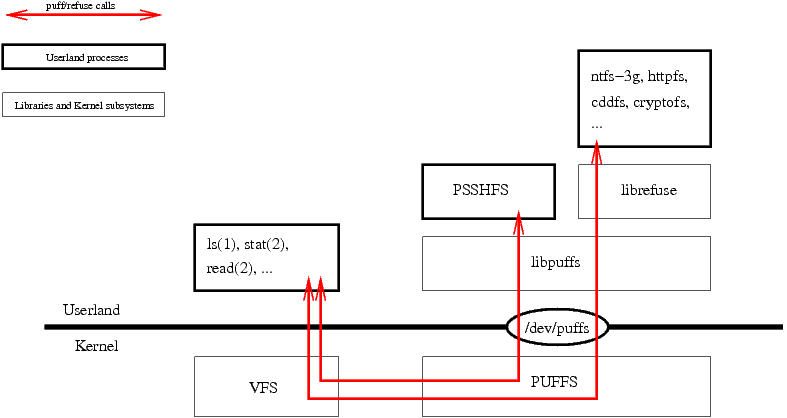Contents
Filesystems in userspace: puffs, refuse, FUSE, and more
About
NetBSD now offers full support for running file systems in userspace. Major components are "puffs", which is the kernel subsystem that realizes the pass-to-userspace framework file system, as well as the userland libraries that support constructing file system implementations. These are libpuffs and the FUSE compatibility library, librefuse.
This page describes the situation in NetBSD 5.0 and later.
Components
There are a number of components interacting to provide routines for userland file systems: puffs as the kernel part, and libpuffs and librefuse to provide functions for userland file systems to call. The following image gives an overview of the components and their connections:

Overview about puffs
The components themselves are:
puffs is the core component inside the kernel. It exposes a file system interface towards the userland programs (accessible via
/dev/puffsand libpuffs), and communicates with the kernel's own idea of files, which are represented as vnodes. The puffs kernel component and how to interface it is described further in the MAN.PUFFS.4 manpage.The libpuffs library is the interface between userland file systems and the kernel component. It provides a number of convenience routines that userland file systems can use, and is described in the MAN.PUFFS.3 manpage.
To facilitate running the huge amount of file systems already available for the FUSE interface, but not dictate the capabilities of puffs by it, it was decided that FUSE support should be provided as a compatibility layer on top of the native puffs interface, which is offered by librefuse. The re-implementation of the FUSE functionality is designed to be source code compatible with FUSE, and it is further described in the refuse(3) manpage.
Examples for puffs and refuse filesystems can be found in the the NetBSD source
tree in src/share/examples/{puffs,refuse}.
Enabling puffs
puffs is enabled by default in GENERIC on major architectures starting from NetBSD 5.0. For a custom kernel, the following are required in the kernel configuration.
file-system PUFFS
pseudo-device putter
Alternatively, modules can be used.
Base system examples
This section presents usage examples for file systems shipped with the NetBSD base system.
psshfs, The NetBSD sshfs
See the manpage for mount_psshfs(8).
# mount_psshfs host.name.tld:/directory /puffs
# ls /puffs
AdobeFnt.lst OS bin public_html
Desktop OpenOffice.org1.1.0 in tmp
...
# cd /puffs
# ls -l .cshrc
-rw-r--r-- 1 39068 2000 4706 Jun 16 01:01 .cshrc
# head -2 .cshrc
# Default .cshrc for Solaris, Irix, ...
#
# md5 .cshrc
MD5 (.cshrc) = 2ad1d2606a5678f312709a388376c2e5
# ls -l test
ls: test: No such file or directory
# date >test
# ls -l test
-rw-r--r-- 1 39068 2000 29 Nov 23 01:19 test
# cat test
Thu Nov 23 01:19:36 MET 2006
# umount /puffs
9P file servers
See the Bell manpage and the NetBSD manpage mount_9p(8).
# mount_9p nobody@192.168.1.2:/tmp /puffs
# cd /puffs
# echo 9puffs in action > msg_from_earth
# ls -l msg_from_earth
-rw-r--r-- 1 nobody wheel 17 Apr 25 23:24 msg_from_earth
# rsh 192.168.1.2 cat /tmp/msg_from_earth
9puffs in action
Since there is currently no support in the implementation for access control or
support for authentication, the account nobody was picked just to prove a point.
The NFS nobody user really does not have anything to do with 9P. Support for
access control and use of pre-established secure connections will be added to
mount_9p on a later date.
pkgsrc & FUSE
FUSE compatibility was added within pkgsrc, and besides the required infrastructure work a number of FUSE packages were added to pkgsrc in the new filesystem category. Example packages that are currently available include:
fuse -- filesystem in userspace (compat headers, pkg-config files, etc.), needed for pkgsrc on Linux
fuse-archivemount -- FUSE gateway to libarchive
fuse-cddfs -- FUSE filesystem that uses libparanoia for audio CDs
fuse-ntfs-3g -- a NTFS driver with read and write support
...
More packages are currently being worked on, please see pkgsrc/filesystems for a full list.
Here is an example of installing and using the FUSE-enabled NTFS-3g implementation:
# cd pkgsrc/filesystems/fuse-ntfs-3g
# make install
# ntfs-3g ntfs.img /ntfs
Using FUSE file systems on NetBSD 4.0 is possible, but in addition to adding puffs support support to the kernel, it requires fetching and manually installing a backport of the ReFUSE library. The library is available here and further instructions are available here.
Further Information
An in-depth technical description of puffs was presented at AsiaBSDCon 2007 in a paper entitled puffs - Pass-to-Userspace Framework File System. The paper and slides are available.
The ReFUSE emulation layer for FUSE file systems is described in ReFUSE: Userspace FUSE Reimplementation Using puffs presented at EuroBSDCon 2007.
A paper discussing the implementation of distributed file systems on top of puffs was presented at AsiaBSDCon 2008.
The puffs(3) manual pages provide further information from a development perspective.
The source code in browsable form:
